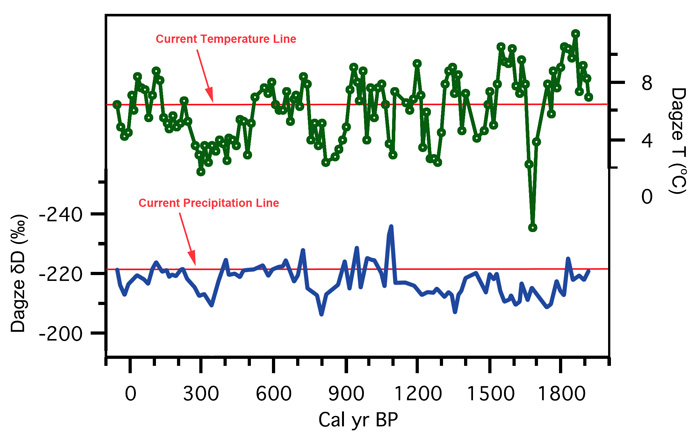| Tweet | Follow @co2science |
Paper Reviewed
Li, X., Liang, J., Hou, J. and Zhang, W. 2015. Centennial-scale climate variability during the past 2000 years on the central Tibetan Plateau. The Holocene 25: 892-899.
Writing as background for their study, Li et al. (2015) state that "interpretation of isotope records is especially difficult in the central Tibetan Plateau (TP), which is located within the conjunction of three climate systems. And, therefore, they state that "independent records of temperature and precipitation isotopes from a single climatic archive are extremely important for assessing the implications of the isotope records and for understanding the mechanisms of past climatic changes on the TP." Consequently, Li et al. set out to obtain just such a proxy reconstruction.
Their work focused on Dagze Co lake (31°49'-31°59'N, 87°25'-87°39'E; 4450 m a.s.l.), a "meromictic, carbonate-rich brackish lake in the central TP," where based on the unsaturation index of long-chain alkenones they derived a decadal-resolution temperature record covering the past 2,000 years. In addition, they derived a record of precipitation isotopes from "compound-specific isotope ratios of leaf waxes." And what did these records reveal?
In the words of the authors, the "centennial-scale variation of the temperature and precipitation isotope records captures well-known climatic events over the past 1,000 years, for example, the 'Little Ice Age', which was cooler and drier than the 'Medieval Warm Period.'" Their record also demonstrates that temperatures were some 2 to 4°C warmer than present during multiple intervals of the past 2,000 years (see figure below). Furthermore, the four Chinese researchers say the Dagze Co lake temperature record "exhibits strong cyclical variability, and spectral analysis reveals a prominent 210-year cycle (>95% confidence interval), which spectral peak, they note, "is well documented in the atmospheric 14C production and 10Be records, which are proxies for solar variability (Damon and Sonett, 1991)," all of which "suggests a higher sensitivity of the regional climate to solar variability during the past 2,000 years." Last of all, Li et al. hasten to add that "the central TP temperature increased during periods of strong solar activity, as indicated by the total solar irradiance record," which they plotted in their Figure 5.

Proxy temperature and precipitation reconstructions from Dagze Co lake, Tibetan Plateau.
As for the significance of Li et al.'s work, their findings run in complete opposition to climate alarmists claims that recent decades have witnessed a CO2-induced influence on climate. Proxy temperature and precipitation values of the recent past are not unusual, uncommon or unprecedented in the context of the past two millennia, nor do they appear to bare any relation to the modern rise in atmospheric CO2 concentration.
Reference
Damon, P.E. and Sonett, C.P. 1991. Solar and terrestrial components of the atmospheric 14C variation spectrum. In: Sonett, C.P., Giampapa, M.S. and Matthews, M.S. (eds) The Sun in time. Tucson, AZ: The University of Arizona Press, pp. 360-388.




